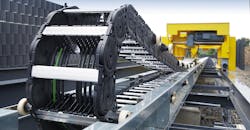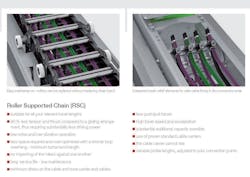A New Cable Management Solution Untangles Seaport Cranes
Cable management is quickly becoming a critical issue across our seaports and docks.
These modern cranes, operating at extreme speed over extraordinary lengths, are pushing traditional cable management methods to their design limit.
To address these concerns, Tsubaki KabelSchlepp developed the next evolution in cable carriers with the creation of the Roller Supported Chain (RSC) system. The RSC system has been specifically designed to solve cable management needs within the port crane industry.
The RSC System
Traditional methods of cable management on port cranes has generally been handled with festoon systems or increasing more often with standard cable carriers.The development of the RSC System resolves the shortcomings of this method.
The RSC system does not use rollers built into the cable carrier, because having the wheels as part of the link construction can cause excessive vibration and jams that will lead to accelerated wear and eventually total replacement of the cable carrier. The RSC system was designed so that the upper run of the cable carrier never comes in contact with the lower run of the cable carrier like traditional cable carrier designs.
The RSC system uses maintenance-free ball bearing rollers that are mounted onto the side of the cable carrier. The rollers are fully exposed and roll on the smooth top surface of the guide channel. With this design, no bounce or vibration is caused by the wheels rolling on top of each other. Not only does this insure low noise and vibration during operation, but also reduces the tow forces by 90% in comparison to traditional cable carrier systems, and even greater in comparison to festoon systems.
This reduction in tow force minimizes the wear on the cable carrier which greatly increases the life. The design also insures that all components on the RSC system are easily accessible. Recesses in the guide channel make it easy to reach the rollers and modular side parts. This allows for easy inspection of the rollers without lifting or touching the cable carrier. Worn rollers can be replaced individually during maintenance if necessary. This means that the time-consuming and expensive replacement of the complete cable carrier is no longer necessary if the wheels wear out.
Special Guide Channels
Another feature of this new system is the specially designed guide channels. These can be mounted together regardless of the defined support distances on the crane. Compared to the usual fixed support distance of 2 meters, the RSC system saves connection points, and therefore steel components, for the support structure. The RSC solution can operate at speeds and distances that have not been obtainable with traditional cable management methods. It can easily operate at speeds in excess of 10 meters per second over a travel distance of 300 meters, carrying a load of 100 lbs. per foot.
RSC vs Festoon
The use of an RSC cable carrier addresses several concerns in comparison to a festoon system that goes beyond just the concern with crane operating speed. With your standard festoon system, each cable needs to be approximately 115% of the length of crane travel. With the RSC cable carrier system, each cable only needs to be approximately 52% of the length of travel. On a long travel port crane system, this reduction in required cable length can translate into a substantial cost savings.
The RSC cable carrier system also requires a much smaller operating envelope in comparison to a festoon system. A typical long travel festoon system can require an operating envelope space as large as 15 feet in height and 5 feet in width. An equivalent long travel RSC cable carrier system may only need an operating envelope 3 feet in height and 2 feet in width.
Even more important to crane operators is the “parking station” that a festoon system requires. A long travel festoon system on a crane often needs up to 10% of total travel distance for this “parking station.” On a ship to shore crane, this “parking station” requirement for the festoon system could easily be in excess of 60 feet. In comparison, an RSC cable carrier system virtually eliminates this requirement, and on an equivalent system would require less than 5 feet of “parking space.” You can easily see how an RSC system can help to increase the operating envelope of typical port cranes and eliminate the addition of extra storage structures.
Another key feature of the RSC cable carrier system is the amount of support it provides the cables. In an RSC cable carrier system the cables are laying horizontally, fully supported and separated inside the cable carrier. In contrast, a festoon system’s cables are only supported periodically at the saddles, leaving the cables left hanging unsupported once the system goes beyond the saddles.
Not only does this hanging add increased stress on the cables, but it also exposes the cable to constant motion from the wind and other outside forces.
Maintenance of cables on an RSC cable carrier system is also much easier in comparison to a festoon system. Replacing a cable on a festoon system will require you to manually release it from each festoon saddle location, and then install the new cable. Not only will this take increased labor, but this new cable will need to be more than twice as long as what the RSC system would require. The RSC system offers quick installation by just pulling the new cable through the carrier, and then strain relieving the cable at each end.
David Smith has been involved with the cable carrier industry for the past 20 years, and has supported customers in a wide variety of industry to design and select the best possible cable carrier solution for their most difficult applications. David is currently the Director of Sales for the KabelSchlepp division of U.S. Tsubaki Power Transmission, where he has been employed for the past 14 years.
About the Author
David Smith
Director of Sales, KabelSchlepp division
David Smith has been involved with the cable carrier industry for the past 20 years, and has supported customers in a wide variety of industry to design and select the best possible cable carrier solution for their most difficult applications. David is currently the Director of Sales for the KabelSchlepp division of U.S. Tsubaki Power Transmission, where he has been employed for the past 14 years.

